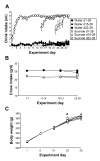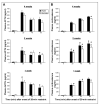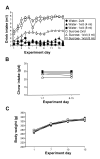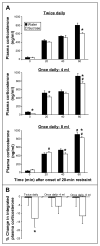HPA axis dampening by limited sucrose intake: reward frequency vs. caloric consumption
- PMID: 21168428
- PMCID: PMC3056892
- DOI: 10.1016/j.physbeh.2010.12.011
HPA axis dampening by limited sucrose intake: reward frequency vs. caloric consumption
Abstract
Individuals often cope with stress by consuming calorically-dense, highly-palatable 'comfort' foods. The present work explores the stress-relieving properties of palatable foods in a rat model of limited sucrose intake. In this model, adult male rats with free access to chow and water are given additional access to a small amount of sucrose drink (or water as a control). A history of such limited sucrose intake reduces the collective (HPA axis, sympathetic, and behavioral-anxiety) stress response. Moreover, the stress-dampening by sucrose appears to be mediated primarily by its rewarding properties, since beneficial effects are reproduced by the noncaloric sweetener saccharin but not oral intragastric gavage of sucrose. The present work uses an alternate strategy to address the hypothesis that the rewarding properties of sucrose mediate its stress-dampening. This work varies the duration, frequency, and/or volume of sucrose and assesses the ability to attenuate HPA axis stress responses. The data indicate that HPA-dampening is optimal with a greater duration and/or frequency of sucrose, whereas increasing the volume of sucrose consumed is without effect. This finding suggests that the primary factor mediating stress-dampening is the number/rate of reward (i.e., sucrose) exposures, rather than the total sucrose calories consumed. Collectively, these data support the hypothesis that stress relief by limited palatable food intake is mediated primarily by its hedonic/rewarding properties. Moreover, the results support the contention that naturally rewarding behaviors are a physiological means to produce stress relief.
Copyright © 2010 Elsevier Inc. All rights reserved.
Figures





Similar articles
-
"Snacking" causes long term attenuation of HPA axis stress responses and enhancement of brain FosB/deltaFosB expression in rats.Physiol Behav. 2011 Apr 18;103(1):111-6. doi: 10.1016/j.physbeh.2011.01.015. Epub 2011 Jan 22. Physiol Behav. 2011. PMID: 21262247 Free PMC article.
-
Daily limited access to sweetened drink attenuates hypothalamic-pituitary-adrenocortical axis stress responses.Endocrinology. 2007 Apr;148(4):1823-34. doi: 10.1210/en.2006-1241. Epub 2007 Jan 4. Endocrinology. 2007. PMID: 17204558 Free PMC article.
-
Western diet-induced obesity interferes with the HPA axis-blunting effects of palatable food in male rats.Physiol Behav. 2023 Oct 15;270:114285. doi: 10.1016/j.physbeh.2023.114285. Epub 2023 Jun 29. Physiol Behav. 2023. PMID: 37392828 Free PMC article.
-
Limited cheese intake reduces HPA axis and behavioral stress responses in male rats.Physiol Behav. 2021 Dec 1;242:113614. doi: 10.1016/j.physbeh.2021.113614. Epub 2021 Oct 1. Physiol Behav. 2021. PMID: 34600921 Free PMC article.
-
Stress exposure, food intake and emotional state.Stress. 2015;18(4):381-99. doi: 10.3109/10253890.2015.1062981. Epub 2015 Aug 13. Stress. 2015. PMID: 26303312 Free PMC article. Review.
Cited by
-
Statistical modeling implicates neuroanatomical circuit mediating stress relief by 'comfort' food.Brain Struct Funct. 2016 Jul;221(6):3141-56. doi: 10.1007/s00429-015-1092-x. Epub 2015 Aug 6. Brain Struct Funct. 2016. PMID: 26246177 Free PMC article.
-
Higher dietary glycemic load is inversely associated with stress prevalence among Iranian adults.BMC Neurosci. 2022 May 20;23(1):28. doi: 10.1186/s12868-022-00713-z. BMC Neurosci. 2022. PMID: 35596143 Free PMC article.
-
The dynamic influence of nutrition on prolonged cognitive healthspan across the life course: A perspective review.Neurosci Appl. 2024 May 6;3:104072. doi: 10.1016/j.nsa.2024.104072. eCollection 2024. Neurosci Appl. 2024. PMID: 40656107 Free PMC article. Review.
-
Palatable food avoidance and acceptance learning with different stressors in female rats.Neuroscience. 2013 Apr 3;235:149-58. doi: 10.1016/j.neuroscience.2012.12.068. Epub 2013 Feb 1. Neuroscience. 2013. PMID: 23380501 Free PMC article.
-
Sucrose self-administration and CNS activation in the rat.Am J Physiol Regul Integr Comp Physiol. 2011 Apr;300(4):R876-84. doi: 10.1152/ajpregu.00655.2010. Epub 2011 Feb 9. Am J Physiol Regul Integr Comp Physiol. 2011. PMID: 21307361 Free PMC article.
References
-
- Mokdad AH, Serdula MK, Dietz WH, Bowman BA, Marks JS, Koplan JP. The continuing epidemic of obesity in the United States. Jama. 2000;284:1650–1. - PubMed
-
- Hill JO, Peters JC. Environmental contributions to the obesity epidemic. Science. 1998;280:1371–4. - PubMed
-
- Coccurello R, D’Amato FR, Moles A. Chronic social stress, hedonism and vulnerability to obesity: lessons from rodents. Neurosci Biobehav Rev. 2009;33:537–50. - PubMed
-
- Torres SJ, Nowson CA. Relationship between stress, eating behavior, and obesity. Nutrition. 2007;23:887–94. - PubMed
-
- Wardle J, Steptoe A, Oliver G, Lipsey Z. Stress, dietary restraint and food intake. J Psychosom Res. 2000;48:195–202. - PubMed
Publication types
MeSH terms
Substances
Grants and funding
LinkOut - more resources
Full Text Sources

